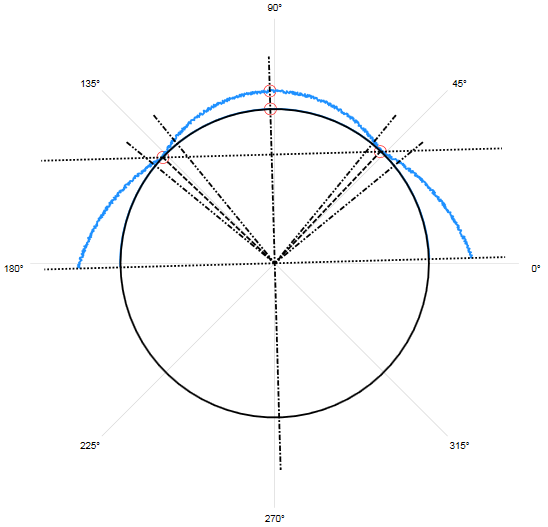PiWeb-Formplots
Circle-in-profile plot

Description
The circle-in-profile plot is displaying a circle, fitted into measured points. It’s a specialized version of the circle plot, with the additional ability to display angular deviations, and touching points, with their respective tolerances.
Point structure
- Angle (radians)
- Deviation
Geometry
The circle-in-profile geometry can be used to define two touching points (FirstTouchingPoint and SecondTouchingPoint) and a point of maximum distance (MaxGapPoint). The nominal touching point defines the angle, around which the tolerance of the point spans. The acual touching point defines the tolerance, as well as the actual angle of the touching point. The same logic applies to the MaxGapPoint.
These special points can be part of the plots point list, but are usually defined separately.
Example
var plot = new CircleInProfilePlot();
var segment = new Segment<CircleInProfilePoint, CircleInProfileGeometry>( "All", SegmentTypes.Line );
plot.Segments.Add( segment )
var rand = new Random( DateTime.Now.Millisecond );
var angleShift = ( rand.NextDouble() - 0.5 ) * 0.25;
for( var i = 0; i < count; i++ )
{
var angle = (double)i / count * Math.PI;
var deviation = Math.Abs( Math.Sin( angle ) - Math.Sin( 0.25 * Math.PI ) ) * 0.1 + ( rand.NextDouble() - 0.5 ) * 0.005;
var point = new CircleInProfilePoint( angle + angleShift, deviation );
if( i == count / 4 )
{
plot.Nominal.FirstTouchingPoint = new CircleInProfilePoint( angle, 0 );
//To create an angular tolerance, add it to the actual touching points.
//The tolerance spans around the nominal touching point angle.
plot.Actual.FirstTouchingPoint = new CircleInProfilePoint( point.Angle, point.Deviation )
{
Tolerance = new Tolerance( -0.1, 0.1 )
};
}
if( i == count / 4 * 3 )
{
plot.Nominal.SecondTouchingPoint = new CircleInProfilePoint( angle, 0 );
//To create an angular tolerance, add it to the actual touching points.
//The tolerance spans around the nominal touching point angle.
plot.Actual.SecondTouchingPoint = new CircleInProfilePoint( point.Angle, point.Deviation )
{
Tolerance = new Tolerance( -0.1, 0.1 )
};
}
if( i == count / 2 )
{
plot.Nominal.MaxGapPoint = new CircleInProfilePoint( angle, 0 );
plot.Actual.MaxGapPoint = new CircleInProfilePoint( point.Angle, point.Deviation );
}
segment.Points.Add( point );
}
plot.Tolerance = new Tolerance( 0.1 );
plot.DefaultErrorScaling = 250;